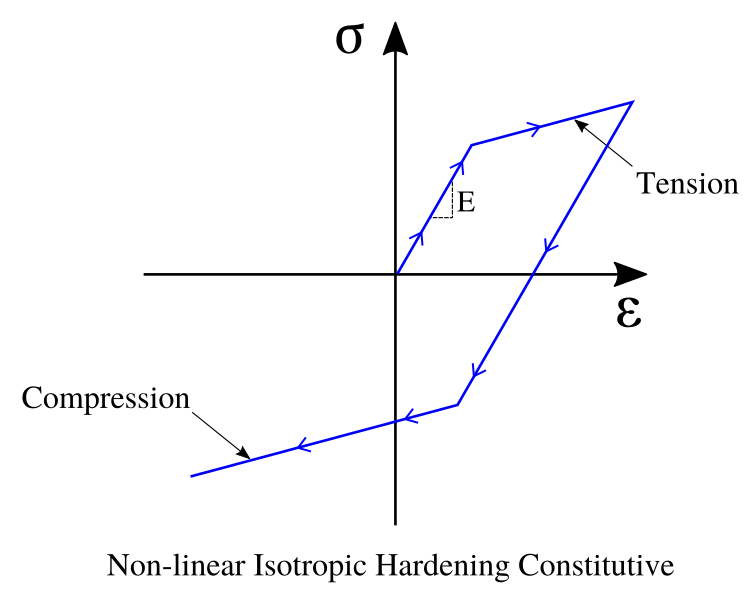The Plastic1DJ2 class creates a uniaxial material class described in [Simo1997] with the constitutive equation given as
\[ \sigma = E \left( \epsilon - \epsilon^p \right) \]
where \(\sigma\) is the uniaxial stress, \(\epsilon\) is the uniaxial strain, and \(E\) is the elasticity modulus. Figure shows the constitutive law of this material.

REFERENCE:
The python Pre-Analysis in the 01-Pre_Process/Method/Attach.py file provides with an interface to populate the Entities dictionary. This file contains several functions to populate specific fields. For example, to create a Plastic1DJ2 material using json format, use:
addMaterial(tag, name='Plastic1DJ2', attributes):
Example
A PLASTIC1DJ2 material can be defined using the python interface as follows:
SVL.addMaterial(tag=1, name='Plastic1DJ2', attributes={'E': 10.0, 'nu': 0.0, 'k': 0.0, 'h': 3.75, 'Sy': 0.25})
Application
Please refer to the A03-DY_Lin_2D_Plastic_ZeroLength.py file located at 03-Validations/01-Debugging/ to see an example on how to define a Plastic1DJ2 material.
On the contrary, the 01-Pre_Process/Method/Remove.py file provides with an interface to depopulate the Entities dictionary. For example, to remove an already define Material, use:
The C++ Run-Analysis in the 02-Run_Process/02-Materials/02-NonLinear/Plastic1DJ2.cpp file provides the class implementation. A Plastic1DJ2 material is created using the built-in json parse-structure provided in the Driver.hpp. A Plastic1DJ2 is defined inside the "Materials" json field indicating its "Tag" as follows,
{
"Materials": {
"Tag": {
"name" : "PLASTIC1DJ2",
"attributes": {
"E": double,
"nu": double,
"rho": double,
"k": double,
"h": double,
"Sy": double
}
}
}
}
| Variable | Description |
|---|---|
Tag | Unique material object identifier. |
E | Represents the elasticity modulus. |
nu | Represents the Poisson's ratio. |
rho | Represents the material density. |
k | Represents the kinematic modulus. |
h | Represents the hardening modulus. |
Sy | Represents the yielding stress. |
A uniaxial PLASTIC1DJ2 material with elasticity modulus 200, Poisson's ratio 0.25, no density, no hardening modulus, and kinematic modulus 3.75 and yield stress of 0.25 is defined as:
{ "Materials": { "1": { "name" : "PLASTIC1DJ2", "attributes": { "E": 200.0, "nu": 0.25, "rho": 0.0, "k": 0.0, "h": 3.75, "Sy": 0.25 } } } }